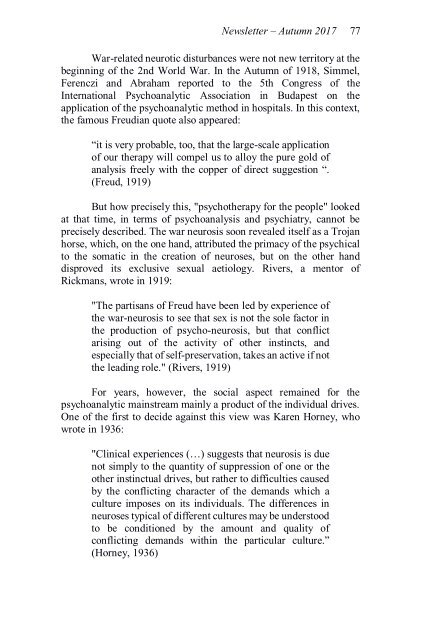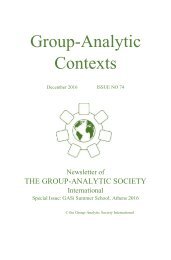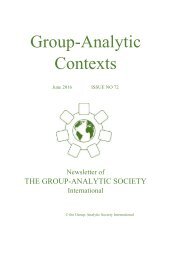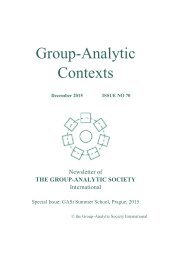Group Analytic Contexts, Issue 77, September 2017
Newsletter of the Group Analytic Society International
Newsletter of the Group Analytic Society International
Create successful ePaper yourself
Turn your PDF publications into a flip-book with our unique Google optimized e-Paper software.
Newsletter – Autumn <strong>2017</strong> <strong>77</strong><br />
War-related neurotic disturbances were not new territory at the<br />
beginning of the 2nd World War. In the Autumn of 1918, Simmel,<br />
Ferenczi and Abraham reported to the 5th Congress of the<br />
International Psychoanalytic Association in Budapest on the<br />
application of the psychoanalytic method in hospitals. In this context,<br />
the famous Freudian quote also appeared:<br />
“it is very probable, too, that the large-scale application<br />
of our therapy will compel us to alloy the pure gold of<br />
analysis freely with the copper of direct suggestion “.<br />
(Freud, 1919)<br />
But how precisely this, "psychotherapy for the people" looked<br />
at that time, in terms of psychoanalysis and psychiatry, cannot be<br />
precisely described. The war neurosis soon revealed itself as a Trojan<br />
horse, which, on the one hand, attributed the primacy of the psychical<br />
to the somatic in the creation of neuroses, but on the other hand<br />
disproved its exclusive sexual aetiology. Rivers, a mentor of<br />
Rickmans, wrote in 1919:<br />
"The partisans of Freud have been led by experience of<br />
the war-neurosis to see that sex is not the sole factor in<br />
the production of psycho-neurosis, but that conflict<br />
arising out of the activity of other instincts, and<br />
especially that of self-preservation, takes an active if not<br />
the leading role." (Rivers, 1919)<br />
For years, however, the social aspect remained for the<br />
psychoanalytic mainstream mainly a product of the individual drives.<br />
One of the first to decide against this view was Karen Horney, who<br />
wrote in 1936:<br />
"Clinical experiences (…) suggests that neurosis is due<br />
not simply to the quantity of suppression of one or the<br />
other instinctual drives, but rather to difficulties caused<br />
by the conflicting character of the demands which a<br />
culture imposes on its individuals. The differences in<br />
neuroses typical of different cultures may be understood<br />
to be conditioned by the amount and quality of<br />
conflicting demands within the particular culture.”<br />
(Horney, 1936)













